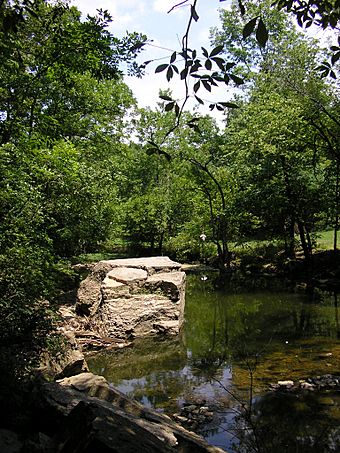Parkways of Louisville, Kentucky facts for kids
Quick facts for kids |
|
|
Olmsted Park System
|
|

Cherokee Park
|
|
| Lua error in Module:Location_map at line 420: attempt to index field 'wikibase' (a nil value). | |
| Location | Louisville, Kentucky |
|---|---|
| Built | 1891 |
| Architect | Frederick Law Olmsted |
| NRHP reference No. | 82002715 |
| Added to NRHP | May 17, 1982 |
The Olmsted Park System in Louisville, Kentucky, is a special network of parks and roads called parkways. It was designed by a very famous landscape architect named Frederick Law Olmsted and his team. This system is about 26 miles (42 km) long. It was built between the early 1890s and the 1930s.
The idea was to create a big loop around what was then the edge of Louisville. However, a small part of the loop was never finished. This means there's a small gap between some of the parkways. Today, the Louisville Olmsted Parks Conservancy helps manage this amazing park system.
Contents
Building the Park System
The idea for this park system started in 1887. A businessman named Andrew Cowan suggested building a series of parkways. These roads would connect three big parks planned for the east, west, and south sides of the city.
Even though Cowan wanted a slow building process, the mayor, Charles Donald Jacob, quickly bought land for Iroquois Park a year later. He also started getting land donations for a wide road called "Grand Boulevard." This road, later named Southern Parkway, would connect the park to the city. Mayor Jacob even said it would be as grand as the Champs-Élysées in Paris!
In 1890, a special parks commission was created. They hired Olmsted's firm to design the whole system. In 1891, the firm shared their plan. It included three large parks and the parkways to link them all together.
The parkways were first meant for light cars and carriages, like for people enjoying a leisurely drive. Heavy trucks and commercial vehicles were not allowed. It wasn't until 1958 that all types of traffic could use the parkways. As Louisville grew, these roads became very busy. They were widened, and some of the grassy areas and tree-lined paths were changed.
Even so, in 2000, about 75% of the original trees were still there or had been replaced. In 1994, there were over 5,000 trees along the parkways! Between 2008 and 2011, a big project helped restore many trees that were damaged. This helped bring back the beautiful tree canopy that Olmsted had planned.
The Parkways
Algonquin Parkway
Algonquin Parkway connects the western parkways to Southern and Eastern Parkways. It runs east-to-west across the city. This was the last parkway to be finished, partly done in 1928. It was originally quite narrow, but it was widened in the late 1930s by workers from the Works Progress Administration.
Algonquin Parkway has changed a lot from its original design.
Eastern Parkway
Eastern Parkway starts near the University of Louisville. There's a small gap here that connects to Southern Parkway. The part of the parkway that goes through the university used to be very narrow, causing traffic jams. In 1954, a special bridge, called a viaduct, was built over the campus to fix this.
When the viaduct opened, the mayor was the first to drive over it. But right after him, two cars crashed trying to be second! Today, this part of the parkway has one lane for cars in each direction and special lanes for bikes. East of the university, Eastern Parkway becomes more residential, with houses and apartments.
The parkway crosses over Beargrass Creek on a bridge built in 1961. A long section of the parkway has a grassy area in the middle with old trees. Eastern Parkway ends at a roundabout near the entrance to Cherokee Park. In the middle of the roundabout is a statue of Daniel Boone.
Eastern Parkway is also part of US 60 for most of its length. A big part of the land for Eastern Parkway was given by John Breckinridge Castleman. This is why there's a sharp turn at Baxter Avenue.
Even though Eastern Parkway was designed for fun drives, it's now a very important road. It connects busy parts of Louisville like The Highlands to places like the University of Louisville. Because of this, it often has a lot more traffic than it was built for. People have suggested ways to make it safer, like adding more bike lanes.
Northwestern and Southwestern Parkways
These two parkways were originally called just Western Parkway. A lot of the land for these roads was given by a local leader named John Henry Whallen. He lived near what is now Chickasaw Park.
Southern Parkway
Southern Parkway was first called Grand Boulevard. It runs from near Churchill Downs to the entrance of Iroquois Park. It starts close to where Eastern Parkway begins, so you can easily use both to connect Iroquois Park to Cherokee Park.
This parkway was renamed Southern Parkway on June 6, 1893. It opened to the public just eight days later.

